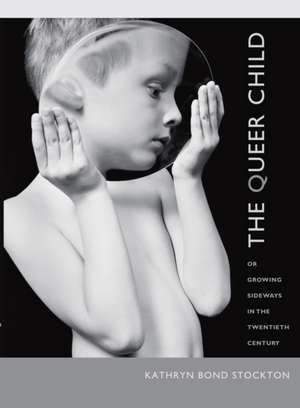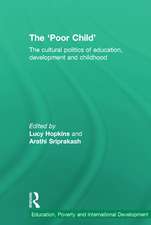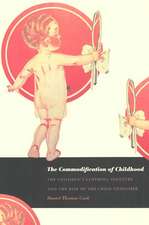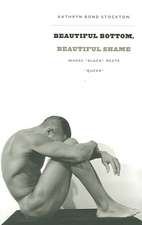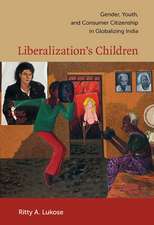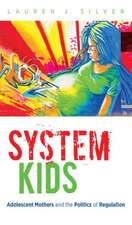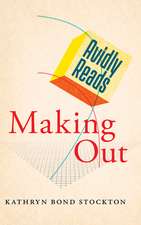The Queer Child, or Growing Sideways in the Twentieth Century: Series Q
Autor Kathryn Bond Stocktonen Limba Engleză Paperback – 19 oct 2009
Din seria Series Q
-
 Preț: 240.90 lei
Preț: 240.90 lei -
 Preț: 174.69 lei
Preț: 174.69 lei -
 Preț: 146.75 lei
Preț: 146.75 lei -
 Preț: 217.18 lei
Preț: 217.18 lei -
 Preț: 176.68 lei
Preț: 176.68 lei -
 Preț: 158.81 lei
Preț: 158.81 lei -
 Preț: 169.81 lei
Preț: 169.81 lei -
 Preț: 227.14 lei
Preț: 227.14 lei -
 Preț: 168.75 lei
Preț: 168.75 lei -
 Preț: 191.15 lei
Preț: 191.15 lei -
 Preț: 191.36 lei
Preț: 191.36 lei -
 Preț: 151.58 lei
Preț: 151.58 lei -
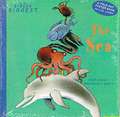 Preț: 243.90 lei
Preț: 243.90 lei -
 Preț: 193.54 lei
Preț: 193.54 lei -
 Preț: 210.82 lei
Preț: 210.82 lei -
 Preț: 217.18 lei
Preț: 217.18 lei -
 Preț: 151.08 lei
Preț: 151.08 lei -
 Preț: 264.26 lei
Preț: 264.26 lei -
 Preț: 231.22 lei
Preț: 231.22 lei -
 Preț: 266.93 lei
Preț: 266.93 lei -
 Preț: 305.08 lei
Preț: 305.08 lei -
 Preț: 230.02 lei
Preț: 230.02 lei -
 Preț: 314.12 lei
Preț: 314.12 lei -
 Preț: 304.47 lei
Preț: 304.47 lei -
 Preț: 264.26 lei
Preț: 264.26 lei -
 Preț: 267.70 lei
Preț: 267.70 lei -
 Preț: 262.32 lei
Preț: 262.32 lei -
 Preț: 236.86 lei
Preț: 236.86 lei -
 Preț: 270.20 lei
Preț: 270.20 lei -
 Preț: 265.79 lei
Preț: 265.79 lei -
 Preț: 229.09 lei
Preț: 229.09 lei -
 Preț: 231.60 lei
Preț: 231.60 lei -
 Preț: 270.31 lei
Preț: 270.31 lei - 5%
 Preț: 197.54 lei
Preț: 197.54 lei - 9%
 Preț: 667.83 lei
Preț: 667.83 lei - 15%
 Preț: 623.39 lei
Preț: 623.39 lei -
 Preț: 259.54 lei
Preț: 259.54 lei
Preț: 194.37 lei
Nou
Puncte Express: 292
Preț estimativ în valută:
37.20€ • 38.79$ • 30.91£
37.20€ • 38.79$ • 30.91£
Carte disponibilă
Livrare economică 27 februarie-13 martie
Livrare express 13-19 februarie pentru 31.91 lei
Preluare comenzi: 021 569.72.76
Specificații
ISBN-13: 9780822343868
ISBN-10: 082234386X
Pagini: 312
Ilustrații: 44 illustrations
Dimensiuni: 160 x 216 x 28 mm
Greutate: 0.5 kg
Editura: MD – Duke University Press
Seria Series Q
Locul publicării:United States
ISBN-10: 082234386X
Pagini: 312
Ilustrații: 44 illustrations
Dimensiuni: 160 x 216 x 28 mm
Greutate: 0.5 kg
Editura: MD – Duke University Press
Seria Series Q
Locul publicării:United States
Cuprins
Contents; AcknowledgmentsIntro: Growing Sideways, or Why Children Appear to Get Queerer in the Twentieth Century; Part 1 Sideways Relations: Pedophiles and Animals; 1. The Smart Child Is the Masochistic Child: Pedagogy, Pedophilia, and the Pleasures of Harm; 2. Why the (Lesbian) Child Requires an Interval of Animal: The Family Dog as a Time Machine; Part 2 Sideways Motions: Sexual Motives, Criminal Motives; 3. What Drives the Sexual Child? The Mysterious Motions of Childrens Motives; 4. Feeling Like Killing? Murderous Motives of the Queer Child; Part 3 Sideways Futures: Color and Money; 5. Oedipus Raced, or the Child Queered by Color: Birthing Your Parents via Intrusions; Conclusion. Money Is the Childs Queer Ride: Sexing and Racing around the Future Notes; Bibliography; Index
Recenzii
"Brilliantly queer, the child is for Stockton not a being but a troubling act of looking at the self: this is why the child vindicates the strangeness ofany form of sexuality.... Stocktons complex defence of fantasy is remarkably effective in showing us how much cultural work the child can silently do, as Jo-Ann Wallace has demonstrated. Leading us through discussions ranging from the literal growing sideways of the fat teenager in The Hanging Garden, (1996) to mothering in The Childrens Hour (1961), A.I. (2001) and Djuna Barnessfiction, Stockton looks at many dangerous children, and helps us along this journey by providing us with the categories of the ghostly gay child,the grown homosexual, and the child queered by Freud." Daniela Caselli, New Formations I dont know when Ive been so captivated by a book and eager to get to the next page. That it is original and that it addresses a topic, the queer child, pretty much completely ignored is one mark of its importance. Even more striking though is the ease with which stunning insights are delivered as if they were a matter of course. Many readers will be struck by the centrality of Kathryn Bond Stocktons book and the graceful way it exposes and breaks the silence surrounding the queer child. James R. Kincaid, author of Erotic Innocence: The Culture of Child Molesting
I consider Kathryn Bond Stockton to be one of the most impressive and important queer critics in the academy today, and The Queer Child, or Growing Sideways in the Twentieth Century only confirms that assessment. It is magnificent: the kind of book that defines the field and is returned to again and again, inspiring all sorts of thought and work for generations to come.--Michael Cobb, author of God Hates Fags: The Rhetorics of Religious Violence
I consider Kathryn Bond Stockton to be one of the most impressive and important queer critics in the academy today, and The Queer Child, or Growing Sideways in the Twentieth Century only confirms that assessment. It is magnificent: the kind of book that defines the field and is returned to again and again, inspiring all sorts of thought and work for generations to come.--Michael Cobb, author of God Hates Fags: The Rhetorics of Religious Violence
Notă biografică
Textul de pe ultima copertă
"I consider Kathryn Bond Stockton to be one of the most impressive and important queer critics in the academy today, and "The Queer Child, or Growing Sideways in the Twentieth Century" only confirms that assessment. It is magnificent: the kind of book that defines the field and is returned to again and again, inspiring all sorts of thought and work for generations to come."--Michael Cobb, author of" God Hates Fags: The Rhetorics of Religious Violence"
Descriere
A study of the queer child, using literary, psychoanalytic, and cultural theory
